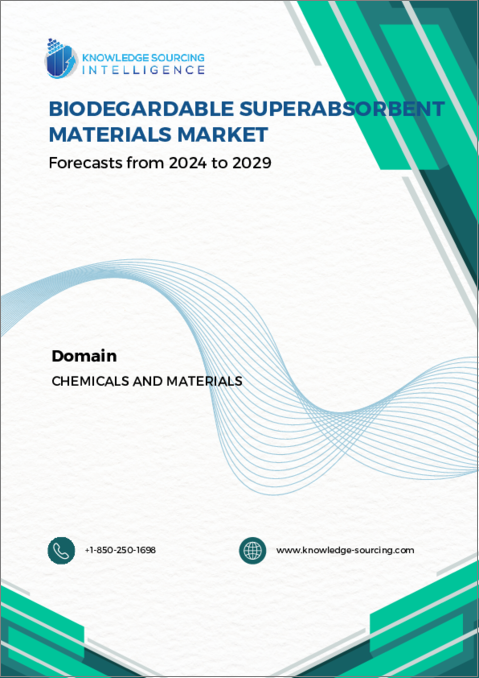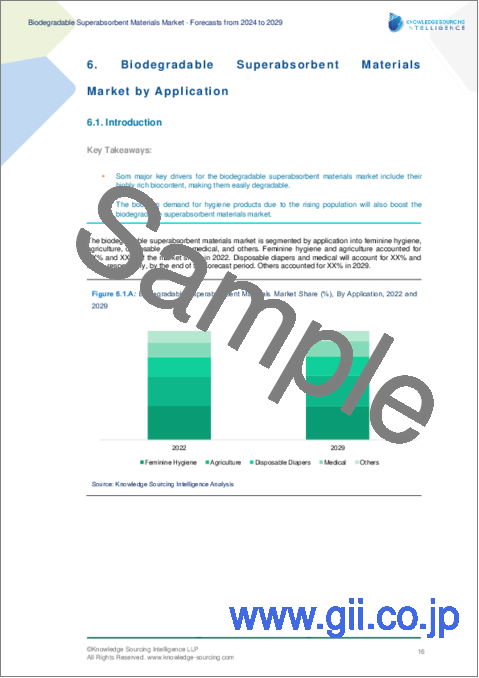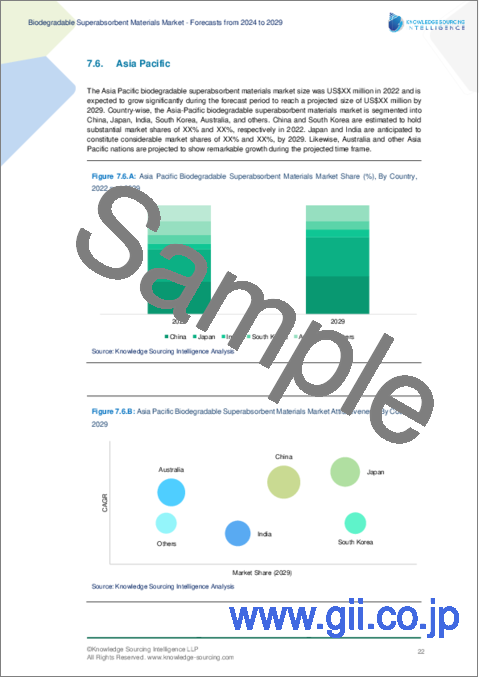|
|
市場調査レポート
商品コード
1532954
生分解性高吸水性材料市場 - 2024年から2029年までの予測Biodegradable Superabsorbent Materials Market - Forecasts from 2024 to 2029 |
||||||
カスタマイズ可能
|
|||||||
| 生分解性高吸水性材料市場 - 2024年から2029年までの予測 |
|
出版日: 2024年07月03日
発行: Knowledge Sourcing Intelligence
ページ情報: 英文 135 Pages
納期: 即日から翌営業日
|
- 全表示
- 概要
- 目次
生分解性高吸水性材料市場は、2024年の2億2,224万4,000米ドルから2029年には2億9,622万米ドルまで、CAGR5.91%で成長すると予測されています。
生分解性高吸水性材料は吸収率の高いポリマーでできています。その豊富なバイオコンテンツにより、容易に分解可能です。このような材料は、個人衛生や医療ケア製品への応用が進んでいます。持続可能性と生体適合性材料の使用へのシフトが進行しているため、このような材料の需要は長期的には市場の上昇傾向を示すと推定されます。
高吸水性ポリマーは、女性用生理用ナプキン、乳幼児用紙おむつ、大人用失禁など、さまざまな製品に使用されているため、高吸水性ポリマーの使用は衛生業界をダイナミックに変えました。これは、高吸水性ポリマーが液体の保持を助け、漏れを防ぐからです。さらに、消費者向け製品以外にも、生分解性高吸水性材料は農業分野にも進出しています。この分野では、土壌の養分消費量と水分使用量を最小限に抑えるため、園芸に応用され、土壌改良の効果を発揮しています。園芸以外にも、この資材は作物の水分ストレスを軽減し、いくつかの病原菌の能力を制御します。
農業の他にも、廃水治療や鉱業などの分野もこのような資材の使用に投資しており、市場の上昇軌道をさらに導いています。
生分解性高吸水性材料市場の促進要因:
- 人口増加による衛生製品に対する需要の高まりが、生分解性高吸水性材料市場を押し上げると予想されます。
生理用ナプキンや高吸水性ポリマーのような個人用・女性用衛生用品には、通常、吸収能力を向上させる綿製が加えられます。グリーン紙おむつや生物分解性紙おむつは、埋め立て地に蓄積され、分解に何年もかかる化学製紙おむつに比べ、費用対効果が高く、簡単に分解できます。
生分解性紙おむつは、部分的に中和された架橋ポリアクリル酸ナトリウムを含んでおり、環境に優しく、赤ちゃんに毒性がないです。ベビーケア製品に持続可能な材料を推進する傾向が強まるにつれ、バイオ成分を豊富に含む高吸水性材料の需要も増加すると予想されます。そのため、企業は環境に優しい紙おむつを強化するために製造設備に投資しています。例えば、アンドリッツは2023年5月、90%持続可能な材料をベースにしたベビー用紙おむつを生産するためのコンバーティングライン設備の設置にフランスで成功しました。
さらに、人口の増加が持続可能な材料の需要を圧迫し、生分解性高吸水性材料の使用を促進しています。例えば、人口問題研究所の「世界人口データシート-2023」によると、世界人口は2035年半ばには89億100万人に達し、2050年半ばには97億9,600万人に達すると予想されています。
- 使い捨て廃棄物を最小限に抑えるための好意的な取り組みが、市場拡大を後押ししています。
紙おむつは主にリサイクル不可能なポリエチレン製です。プラスチック廃棄物の世界の増加に伴い、バイオ含有量の高い持続可能な代替品への需要が大きく伸びています。それゆえ、UNEPのような様々な管理当局は、ベビー用紙おむつを含むあらゆる消費者製品における従来のプラスチック使用を禁止する新しい政策や制度を実施しています。
生分解性高吸水性材料市場の地理的展望
- 北米は予測期間中、かなりの市場シェアを占めると予想されます。
地域別に見ると、生分解性高吸水性材料市場は北米、南米、欧州、中東・アフリカ、アジア太平洋に分析されます。北米市場は一定の成長率で推移します。北米市場は、環境に優しい個人用衛生製品、特にベビーケア製品に対する需要の高まりと、プラスチック廃棄物を最小限に抑えるための積極的な取り組みによって、かなりの市場シェアを獲得するものと思われます。
さらに、米国とカナダという主要な地域経済圏に包括的な製品を提供するDSMとBASFという大手市場企業の存在が確立されていることが、このような材料に対する地域市場の需要をさらに高めています。同様に、P&Gのような主要なベビーケア製品メーカーは、自社製品にそのような材料の使用を実装しており、北米地域は彼らの売上高の大部分を占めています。P&Gコーポレーションの2023年の年次報告書によると、ベビー&フェミニンケアは同社の製品総売上高の17%を占め、北米、特に米国がこのセグメントの売上高だけで大きなシェアを占めています。
米国では高齢者人口の増加により、大人用失禁製品の需要がさらに高まっています。米国地域生活管理局によると、米国の人口の16%以上が65歳以上です。女性の衛生に関する意識と生理用ナプキンやタンポンなどの製品に対する需要が、生分解性高吸水性材料の需要をさらに高めています。
生分解性高吸水性材料市場企業と製品:
- AQUALIC(TM) CA:日本触媒の高吸水性樹脂「AQUALIC(TM) CA」は、一貫システムで生産され、環境負荷の低減を目指しています。紙おむつ、生理用品、使い捨てカイロ、ペットシーツ、廃液固形化剤など様々な用途に使用されています。
- HySorb:BASF社が提供するこのSAPは、アクリル酸とアクリル酸ナトリウムを重合して分子鎖を形成することにより製造されます。持続可能な開発に貢献するという同社のコミットメントを示す製品であり、主に紙おむつに使用されています。
- SANWET:「SANWET」はSPD世界の主要な高吸水性ポリマーブランドであり、消費者の様々な用途に必要とされる20種類以上のSAPを含みます。同ブランドの製造は、表面改質(高い液体透過性)、精密重合(高速吸収)、粒子形状制御(高吸収性)の3つの主要技術に基づいています。
- H-600:JRMケミカルズが提供する高吸水性ポリマーH-600は、吸収速度が速く、製品は20秒以内に吸収能力の最大70%に達します。このSAPは迅速な吸収が要求される用途に使用されます。水道水に対しては、重量の350倍の吸収能力を持っています。
生分解性高吸水性材料市場の主な発展
- 2024年3月:The International Chemical Investors Group (ICIG)がEvonik Industriesと合意。この合意により、Evonikは主に紙おむつやその他の衛生用品に使用される高吸水性樹脂事業を売却します。最終的な譲渡は2024年半ばに行われる予定です。
- 2023年10月:LG化学はGS Caltex Accelerateと共同で、環境に優しい材料3HP(ヒドロキシプロピオン酸)を開発。この材料は、コーティング材料から高吸水性ポリマーまで幅広い用途でバイオマテリアルを推進する同社のコミットメントに貢献します。
- 2023年2月:長瀬産業は林原(株)と共同で、バイオマス高含有高吸水性ポリマーの開発に成功。2025年度の上市を予定しており、現在、量産体制と設備を整えています。
- 2022年9月:三洋化成の子会社SDP Global Co.Ltd.は、植物由来のバイオマスを使用した環境に優しい高吸水性ポリマーを開発しました。この開発は、気候変動への対応とカーボンニュートラルへの貢献の一環。
生分解性高吸水性材料市場は以下のようにセグメント化され、分析されています:
製品別
- ポリビニルアルコール(PVC)
- ポリタコン酸
- 多糖類
- ポリペプチド
用途別
- 生理用品
- 農業
- 紙おむつ
- 医療
- その他
地域別
- 北米
- 米国
- カナダ
- メキシコ
- 南米
- ブラジル
- アルゼンチン
- その他
- 欧州
- ドイツ
- フランス
- 英国
- イタリア
- その他
- 中東・アフリカ
- サウジアラビア
- イスラエル
- その他
- アジア太平洋
- 中国
- 日本
- 韓国
- インド
- インドネシア
- 台湾
- その他
目次
第1章 イントロダクション
- 市場概要
- 市場の定義
- 調査範囲
- 市場セグメンテーション
- 通貨
- 前提条件
- 基準年と予測年のタイムライン
- ステークホルダーにとっての主なメリット
第2章 調査手法
- 調査デザイン
- 調査プロセス
第3章 エグゼクティブサマリー
- 主な調査結果
第4章 市場力学
- 市場促進要因
- 市場抑制要因
- ポーターのファイブフォース分析
- 業界バリューチェーン分析
- アナリストの見解
第5章 生分解性高吸水性材料市場:製品別
- イントロダクション
- ポリビニルアルコール(PVC)
- ポリイタコン酸
- 多糖類
- ポリペプチド
第6章 生分解性高吸水性材料市場:用途別
- イントロダクション
- 生理用品
- 農業
- 使い捨ておむつ
- 医療
- その他
第7章 生分解性高吸水性材料市場:地域別
- イントロダクション
- 北米
- 米国
- カナダ
- メキシコ
- 南米
- ブラジル
- アルゼンチン
- その他
- 欧州
- ドイツ
- フランス
- 英国
- イタリア
- その他
- 中東・アフリカ
- サウジアラビア
- イスラエル
- その他
- アジア太平洋地域
- 中国
- 日本
- 韓国
- インド
- インドネシア
- 台湾
- その他
第8章 競合環境と分析
- 主要企業と戦略分析
- 市場シェア分析
- 合併、買収、合意およびコラボレーション
- 競合ダッシュボード
第9章 企業プロファイル
- DSM
- Nippon Shokubai
- Weyerhaeuser
- BASF SE
- SDP Global(Sanyo Chemical)
- Coloplast A/S
- Lubrizol
- JRM Chemical
- AMEREQ, INC.
The biodegradable superabsorbent materials market is anticipated to grow at a CAGR of 5.91% from estimated value of US$222.244 million in 2024 to US$296.220 million in 2029.
Biodegradable superabsorbent materials are made of polymers with high absorbent rates. Due to their rich biocontent, they are easily degradable. The applicability of such materials is rising in personal hygiene and medical care products. With the ongoing shift towards sustainability and biocompatible material usage, the demand for such materials is estimated to show an upward market trajectory in the long run.
The use of superabsorbent polymers dynamically changed the hygiene industry as the polymer is used in various products, such as feminine sanitary napkins, disposable infant diapers, and adult incontinence. This is because it helps in liquid retention, thereby preventing its leak. Moreover, besides consumer products, biodegradable superabsorbent materials are also finding their way into the agriculture sector. In this sector, they are applied in horticulture to minimize soil nutrient consumption and water content usage, thereby demonstrating the benefits of soil amendments. Besides horticulture, the materials also reduce moisture stress in crops and control the capacity for several pathogens.
Besides agriculture, other sectors such as wastewater treatment and mining also invest in such material usage, further leading to an upward market trajectory.
Biodegradable Superabsorbent Materials Market Drivers:
- The booming demand for hygiene products due to the rising population is expected to boost the biodegradable superabsorbent materials market.
Personal and feminine hygiene products such as sanitary napkins and superabsorbent polymers are added, which are usually made of cotton that improves the absorption capacity. Green Diapers or bio-degradable diapers are cost-effective and can be degraded easily compared to chemical-made diapers that accumulate in landfills and take years to degrade.
Biodegradable diapers contain partially neutralized cross-linked sodium polyacrylate, which is environment-friendly and not toxic for babies. With the growing trend of promoting sustainable materials in baby care products, the demand for superabsorbent material with rich bio content is also expected to increase. Hence, companies are investing in manufacturing facilities to bolster eco-friendly diapers. For instance, in May 2023, ANDRITZ successfully installed a converting line facility in France to produce baby diapers based on 90% sustainable materials.
Additionally, the increase in population is putting pressure on sustainable material demand, propelling the use of biodegradable superabsorbent materials. For instance, according to the Population Reference Bureau's "World Population Data Sheet -2023", the global population is expected to reach 8,901 million by mid-2035 and 9,796 million by mid-2050.
- Favorable efforts to minimize disposable waste have propelled the market expansion.
Disposable diapers are mainly made of non-recyclable polyethylene. With the growing plastic waste on a global scale, the demand for sustainable alternatives with high bio-content is witnessing significant growth. Hence, various governing authorities, such as UNEP, are implementing new policies and schemes to ban traditional plastic usage in every consumer product, including baby diapers.
Biodegradable Superabsorbent Materials Market Geographical Outlook
- North America is expected to hold a considerable market share during the forecast period.
Based on geography, the biodegradable superabsorbent materials market is analyzed into North America, South America, Europe, the Middle East and Africa, and Asia Pacific. The North American market is set to grow at a constant rate. It will capture a considerable market share fuelled by the increasing demand for eco-friendly personal hygiene products, especially for baby care, followed by favorable efforts to minimize plastic waste.
Furthermore, the well-established presence of major market players, namely DSM and BASF, that share a comprehensive product offering for the major regional economies, namely the US and Canada, has furthered the regional market demand for such materials. Likewise, major baby care products manufacturers such as P&G are implementing such materials usage in their products and the North American region accounts for a major portion of their sales. As per P&G corporation's 2023 annual report, baby & feminine care accounted for 17% of the company's total product sales, with North America and specifically the United States accounting for a major share of the segment sales alone.
A rise in the geriatric population in the USA has further increased the demand for adult incontinence products. According to the Administration for Community Living USA, more than 16% of people over 65 represent the USA's population. Awareness regarding female hygiene and demand for products such as sanitary napkins and tampons have further increased the demand for biodegradable superabsorbent materials.
Biodegradable Superabsorbent Materials Market Players and Products:
- AQUALIC(TM) CA: Nippon Shokubai's "AQUALIC(TM) CA" superabsorbent polymers are produced in an integrated system and aim to lessen the environmental load. The SPA's are used in various applications such as disposable diapers, feminine hygiene products, disposable hands & body warmers, pet sheets, and waste liquid solidifiers, among others.
- HySorb: This SAP provided by BASF is produced by polymerizing acrylic acid and sodium acrylate to form a molecular chain. The product marks the company's commitment to contributing to sustainable development and is mainly used in disposable diapers.
- SANWET: "SANWET" is SPD Global's major superabsorbent polymer brand, including more than 20 SAPs required for varied consumer use. The brand production is based on three major technologies: surface modification (for high liquid permeability), precise polymerization (for fast absorption), and particle shape control (for higher absorbency).
- H-600: The H-600 Superabsorbent polymer provided by JRM Chemicals offers a fast absorption rate, with the product reaching up to 70% of its absorption capacity within twenty seconds. The SAP is used in applications where rapid absorption is required. Against tap water, it holds an absorption capacity of 350 times its weight.
Biodegradable Superabsorbent Materials Market Key Developments
- March 2024: The International Chemical Investors Group (ICIG) formed an agreement with Evonik Industries. With this agreement, the latter would sell its superabsorbent polymers business, which is mainly used in diapers and other hygiene products. The final transfer is scheduled to take place in mid-2024.
- October 2023: LG Chem collaborated with GS Caltex Accelerate to develop environment-friendly material 3HP (Hydroxpropionic Acid). The material would serve the company's commitment to promoting biomaterial with applications ranging from coatings materials to super absorbent polymers.
- February 2023: NAGASE CO. LTD, in collaboration with Hayashibara Co., Ltd., successfully developed a super absorbent polymer with a high biomass content. The commercial launch is planned for the 2025 fiscal year, and mass production and facilities are currently being established.
- September 2022: Sanyo Chemical's subsidiary SDP Global Co. Ltd developed an eco-friendly superabsorbent polymer using plant-based biomass. The development was part of the company's effort to address climate change and contribute to carbon neutrality.
The Biodegradable Superabsorbent Materials Market is segmented and analyzed as follows:
By Product
- Polyvinyl Alcohol (PVC)
- Polyitaconic Acid
- Polysaccharide
- Polypeptide
By Application
- Feminine Hygiene
- Agriculture
- Disposable Diapers
- Medical
- Others
By Geography
- North America
- United States
- Canada
- Mexico
- South America
- Brazil
- Argentina
- Others
- Europe
- Germany
- France
- United Kingdom
- Italy
- Others
- Middle East and Africa
- Saudi Arabia
- Israel
- Others
- Asia Pacific
- China
- Japan
- South Korea
- India
- Indonesia
- Taiwan
- Others
TABLE OF CONTENTS
1. INTRODUCTION
- 1.1. Market Overview
- 1.2. Market Definition
- 1.3. Scope of the Study
- 1.4. Market Segmentation
- 1.5. Currency
- 1.6. Assumptions
- 1.7. Base and Forecast Years Timeline
- 1.8. Key Benefits for the Stakeholder
2. RESEARCH METHODOLOGY
- 2.1. Research Design
- 2.2. Research Processes
3. EXECUTIVE SUMMARY
- 3.1. Key Findings
4. MARKET DYNAMICS
- 4.1. Market Drivers
- 4.2. Market Restraints
- 4.3. Porter's Five Forces Analysis
- 4.3.1. Bargaining Power of Suppliers
- 4.3.2. Bargaining Power of Buyers
- 4.3.3. Threat of New Entrants
- 4.3.4. Threat of Substitutes
- 4.3.5. Competitive Rivalry in the Industry
- 4.4. Industry Value Chain Analysis
- 4.5. Analyst View
5. BIODEGRADABLE SUPERABSORBENT MATERIALS MARKET BY PRODUCT
- 5.1. Introduction
- 5.2. Polyvinyl Alcohol (PVC)
- 5.3. Polyitaconic Acid
- 5.4. Polysaccharides
- 5.5. Polypeptides
6. BIODEGRADABLE SUPERABSORBENT MATERIALS MARKET BY APPLICATIONS
- 6.1. Introduction
- 6.2. Feminine Hygiene
- 6.3. Agriculture
- 6.4. Disposable Diapers
- 6.5. Medical
- 6.6. Others
7. BIODEGRADABLE SUPERABSORBENT MATERIALS MARKET BY GEOGRAPHY
- 7.1. Introduction
- 7.2. North America
- 7.2.1. United States
- 7.2.2. Canada
- 7.2.3. Mexico
- 7.3. South America
- 7.3.1. Brazil
- 7.3.2. Argentina
- 7.3.3. Others
- 7.4. Europe
- 7.4.1. Germany
- 7.4.2. France
- 7.4.3. United Kingdom
- 7.4.4. Italy
- 7.4.5. Others
- 7.5. Middle East and Africa
- 7.5.1. Saudi Arabia
- 7.5.2. Israel
- 7.5.3. Others
- 7.6. Asia Pacific
- 7.6.1. China
- 7.6.2. Japan
- 7.6.3. South Korea
- 7.6.4. India
- 7.6.5. Indonesia
- 7.6.6. Taiwan
- 7.6.7. Others
8. COMPETITIVE ENVIRONMENT AND ANALYSIS
- 8.1. Major Players and Strategy Analysis
- 8.2. Market Share Analysis
- 8.3. Mergers, Acquisitions, Agreements, and Collaborations
- 8.4. Competitive Dashboard
9. COMPANY PROFILES
- 9.1. DSM
- 9.2. Nippon Shokubai
- 9.3. Weyerhaeuser
- 9.4. BASF SE
- 9.5. SDP Global (Sanyo Chemical)
- 9.6. Coloplast A/S
- 9.7. Lubrizol
- 9.8. JRM Chemical
- 9.9. AMEREQ, INC.






